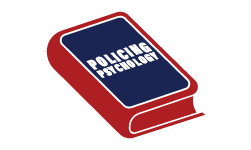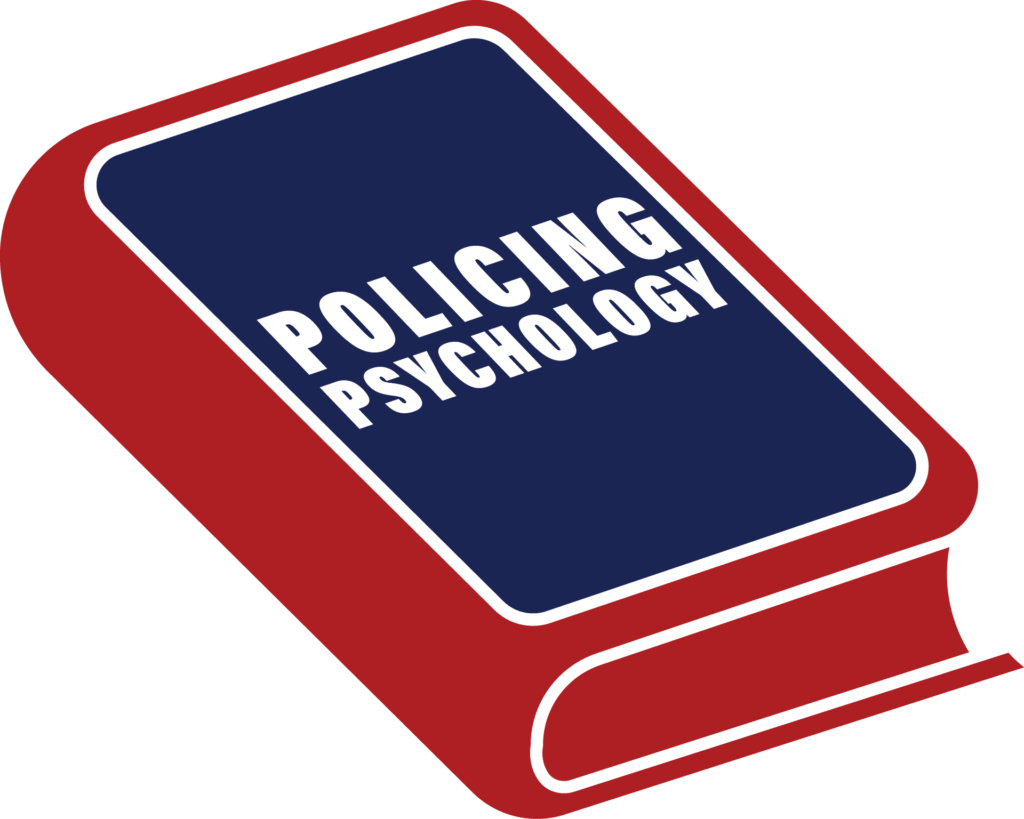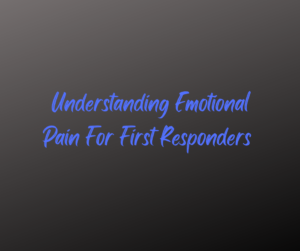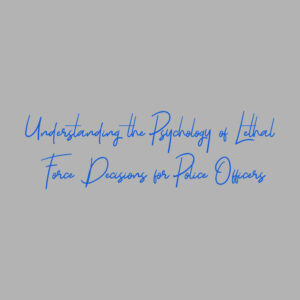Blogs
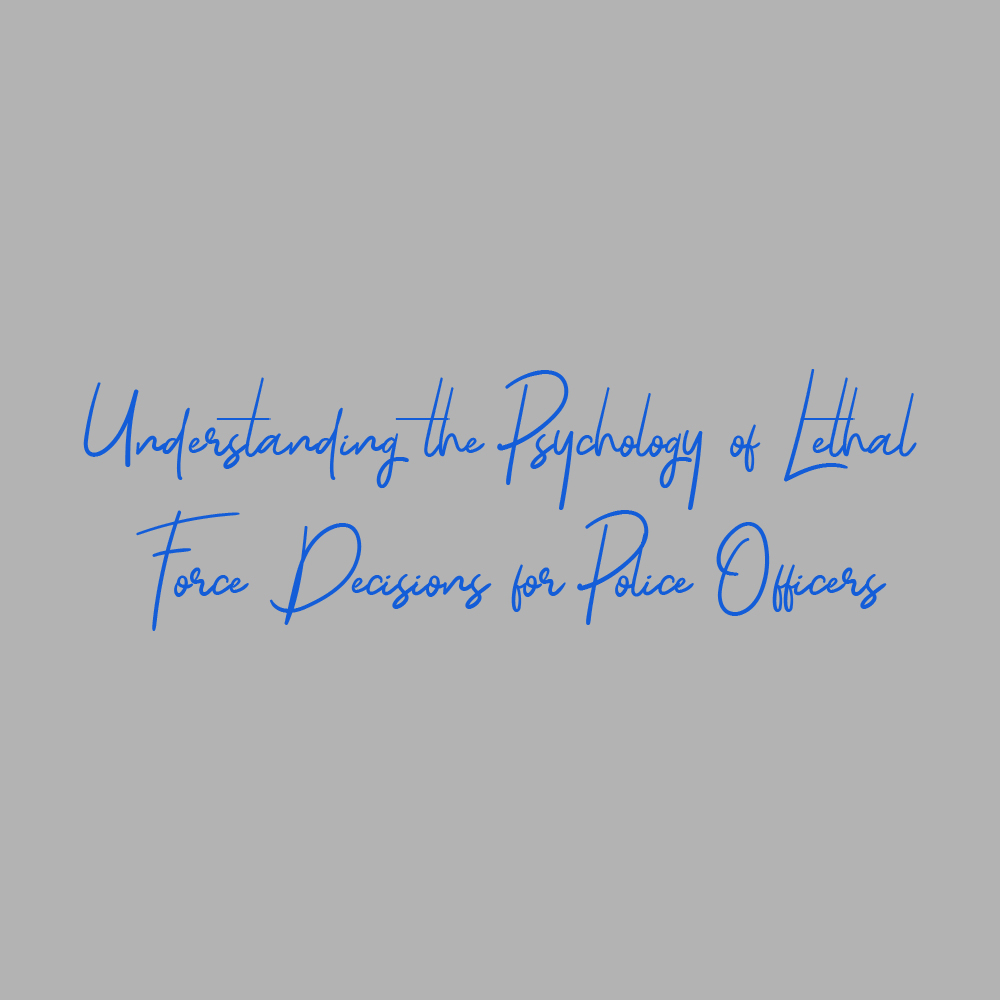
Understanding the Psychology of Lethal Force Decisions for Police Officers
CHAD ROBICHAUX’S EXPERIENCE:
“That morning if you had asked me what I would do if a guy pointed a gun at me,” Chad said, “I would have said, ‘blast him.’” But the reality of the experience was totally different from his expectation of that moment.
Chad had attended a domestic dispute call as a police officer. Chad was able to separate the female victim from the male suspect. The male had a rifle up at his shoulder with his finger near the trigger. Chad didn’t shoot the suspect like he thought he would. Chad kept ordering the suspect to drop the gun.
“Stop or I’m going to kill you.” Chad yelled, as the suspect was walking down a hallway toward him. Chad said that he felt compassion for this man. Chad could see family pictures on the walls in the house. Legally and ethically, Chad was clearly allowed to use lethal force. Shooting this man was much harder to do than he had expected it to be.
Chad eventually grabbed the barrel of the gun and got into a hand-to-hand fight with the man. The male was about 100 pounds bigger than Chad, so this fight did not go well for him. Chad remembered thinking, “you’re going to make me kill you.” Both Chad and his partner were forced to shoot the male, who died of his injuries.
Chad described only hearing muffled “pop-pop” sounds, along with the slide of the gun functioning in slow motion, which was strange to him. The man died in front of Chad, who described himself as covered in blood.
This is one of the police shootings that is described within the book Shots Fired: The Psychology Behind Officer Involved Shootings (click here for summary). This story highlights many important points about police shootings that I want to use to help educate police officers.
LACK OF PSYCHOLOGICAL PREPARATION FOR LETHAL FORCE DECISIONS:
Police officers are trained in the act of using lethal force. But our training needs more preparation on the psychological aspects of using lethal force. As a new cop, I was physically prepared to use force to preserve and protect life, but I was not truly prepared psychologically. I had some training days of shooting guns on a firing range, and a few days of scenario-based training. However, I was not trained about the psychology of lethal force. This post is designed to help readers by providing a brief overview of some literature on the topic, along with some important book suggestions. These are the books that have helped me. These are the books that I wish I had read while preparing for a career in policing.
UNDERSTAND THAT EVERY LETHAL FORCE DECISION IS UNIQUE:
One central starting point is to understand that every lethal force situation that a police officer encounters is unique. There may be some elements that are similar, but there will be a difference in training, resources, gear, cover officers, environments and a number of other factors. Those differences are crucial to understanding this topic. An officer’s reaction to stopping a terrorist who is killing children in a school, may be different than being forced to shoot a mentally ill person who has committed suicide by cop with an imitation weapon.
Even different officers at the same incident can have different perceptions of the event, along with the degree of danger. The officers will each have a variety of training and experience. They will also be in different proximity to the threat, where they are able to perceive different things. We need to let go of what we think our reaction should be in response to an incident because each situation is different from other incidents.
LIFE-LONG DECISIONS WILL BE MADE IN A SPLIT SECOND USING PARTIAL INFORMATION:
Officers will be forced to make life changing decisions, in a split second, using only partial information, while under extreme stress. Those officers will often be judged for years after by countless armchair quarterbacks, many of whom don’t have a fucking clue what they are talking about. Officers will react based on their training and their instincts, often in low light and in high-risk situations. We are all human, despite our best efforts and years of training, mistakes can still happen. We must prepare ourselves so that we are ready to survive the physical dangers and we must also prepare ourselves for the psychological costs that may follow the incident too.
We need to understand that we are forced to make decisions without all of the information. We may not know if it is an imitation firearm or a real one until after the incident. We often will not know that there may be innocent people somewhere in our backdrop, that we may not even be able to see. If we wait until we have all of the information, we will have waited too long. This might cost our life or someone else’s life. We are forced to make a decision, often at a moment’s notice, under incredibly challenging conditions.
NATURAL RESISTANCE TO USING LETHAL FORCE:
Researchers have demonstrated that we as humans have a powerful resistance to using lethal force on another person. Psychologist, Lt. Col. Dave Grossman described this aspect of human psychology in his book On Killing: The Psychological Cost of Learning to Kill in War and Society (click here for summary.) Lt. Col Grossman explains that this is not just a human feature of psychology, as many lethal predators intentionally refuse to kill their own species during intra-species conflict. Some examples include piranhas, who fight each other with their tails and rattle snakes, who wrestle each other.
I have personally heard many anecdotal stories from police officers of these types of situations. Experiences where officers were a partial trigger pull away from using lethal force. I have also talked to many police officers, who felt a large emotional toll of being placed into a position where they had to make lethal force decisions. I believe that many officers have not been prepared to handle the emotional and psychological impacts of those situations.
I describe those feelings because I have also felt them. As a new police officer, I had a subject point an imitation firearm at me, in a suicide by cop attempt. I didn’t shoot him. I exposed myself and my less lethal partner to a threat of death or grievous bodily harm. This impacted me through long-lasting traumatic stress. I spent years experiencing nightmares where I needed to shoot people in my dreams. I did not understand what was happening. I didn’t know that many officers had shared similar experiences before me.
I also had trouble processing my own emotions. I didn’t understand it at the time, but I felt intense feelings of shame and guilt. I judged myself harshly. I was worried that my team would no longer trust me. It took a long time for me to be able to process my feelings and to move forward from them.
WHAT THIS CONCEPT CAN LOOK LIKE IN TRAINING:
I spoke to some police academy instructors who described that during active shooter training, police recruits will often follow an active shooter in a school scenario, yelling repeatedly “drop the gun, drop the gun, drop the gun.” They did not understand how recruits could hesitate for so long to shoot a school shooter in training. It is more challenging to overcome that resistance to using lethal force when the suspect is not posing the lethal threat toward you in the moment.
LESSONS FROM HISOTORY:
In On Killing, Lt. Col. Grossman describes that throughout history, soldiers have been documented to resist using lethal force, even when their lives were directly in danger during warfare. He provides evidence from a variety of historical examples, including the battle of Gettysburg which show that the majority of soldiers refused to kill enemy combatants. Some guns at the battle of Gettysburg were found to have been loaded over 20 times, without being shot. Lt. Col. Grossman also describes many people who throw up after being forced to use lethal force.
THE IMPACT OF DISTANCE TO THE THREAT FOR LETHAL FORCE:
Using lethal force is harder as the distance to the opponent becomes closer. Police shootings, like the one described in this post by Chad and Dean, are often at close range. Therefore, we can expect that many officers would experience a strong resistance to using lethal force. Lt. Col. Grossman said, “at close range the resistance to killing an opponent is tremendous.” He continued that, “most simply cannot and will not do it.”
Lt. Col. Grossman explains that this resistance is so powerful that it overrides a whole host of other factors, including our own self-preservation. He wrote, “the resistance to the close-range killing of one’s own species is so great that it is often sufficient to overcome the cumulative influences of the instinct for self-preservation, the coercive forces of leadership, the expectancy of peers and the obligation to preserve the lives of comrades.”
POSTURE – SUBMIT – FLIGHT – FIGHT:
Humans, like many other animals, will often engage in posturing prior to combat or using lethal force. Many animals, including humans “will go through a series of posturing actions that, while intimidating, are almost always harmless. These actions are designed to convince an opponent, through both sight and sound, that the posturer is a dangerous and frightening adversary.” In policing, we often posture with our firearms toward a potential threat. We need to understand the posturing for what it is, and to be prepared for if someone turns the conflict into a lethal force encounter.
PSYCHOPATHS AND EVIL:
Dean Spivacke, another officer from Shots Fired said, “there are fucked-up people walking around this world, and it’s our job to deal with them.” It may not be a popular thing to say in today’s politically correct society, but he’s right. There are people out there who prey on innocent members of society. They often blend into society, and you will rarely know who they are, until it’s too late. However, it’s important to know that there is evil in the world. There are psychopathic predators who will kill you and won’t feel one bit bad about it. After being involved in multiple police shootings, Dean said, “you don’t have to practice at the range a thousand times, but you have to have in your head that this could happen.”
Dean went on to an investigative role where he investigated shootings. Dean said that many of the officers that had emotional struggles acted appropriately but they were not able to handle the aftermath of the shooting. Dean described how he was able to handle it. “It’s not my fault. If you do your thing and you have to get shot, that’s not my choice. I’m coming home at the end of the day.”
THE SUBJECT DECIDES THE OUTCOME – DO NOT CARRY THAT BURDEN FOR THEM:
For many years, I wrestled with an internal dilemma, that I did not want to have to shoot someone. It was hard for me to accept that I might have to one day. I had to change my thought process. As Dean just described, our use of force model is based off the premise of subject behaviour and officer response. They make the decision. They decide to carry a gun. They decided to hurt people. They decide to put people’s lives in danger, including my own. They can carry the burden of their decision. I won’t carry that burden for them.
This changed how I saw lethal force decisions. I feel fortunate to live in a safe society. I’m sure that people in Iraq and Afghanistan would love to have the safety that we have in North America. That comes at a cost. There are still evil murderers out there. You’re naïve if you think that there aren’t. There are people who will prey on other people. They are not going to stop because we ask them to. Sometimes the only option that they leave us is to use force to stop them.
Police officers have a common law duty to protect life. However, sometimes protecting the lives of some people, come at the cost of using lethal force on another person. The person posing that lethal threat towards others in society is the one who decides the outcome.
DANGERS OF POLICE WORK:
There are physical dangers in doing this. Some people die while keeping others safe. They aren’t a statistic. They are heroes, who sacrifice their lives for their communities. We need to do everything that we can to reduce those losses. We need the best gear, tactics, training and resources. There are also psychological costs to dealing with these situations. We need to prepare officers for the psychological impacts of these lethal force decisions as well. As you can read in Shots Fired, many of the officers have their lives fall apart after their shooting. Some even consider suicide to escape their pain. Both Chad and Dean described experiencing significant emotional pain and trauma.
PHYSIOLOGICAL REACTIONS TO LETHAL FORCE DECISIONS:
In the book On Combat: The Psychology and Physiology of Deadly Conflict in War and Peace (click here for summary), Lt. Col. Grossman and Loren W. Christensen describe the physical reactions to lethal force decisions. One key element is the level of physiological arousal as measured by heart rate. Officers will perform better if they are able to maintain a lower heart rate, whereas a heart rate that goes above 180 beats per minute is associated with decreased performance under stress.
TACTICAL BREATHING – REGAINING CONTROL OF YOUR PHYSIOLOGY:
In On Combat, the authors describe the ability to gain control of our sympathetic nervous system arousal through combat breathing. They describe combat breathing as a technique of slowing your breath, which will also slow your heart rate. It enables officers to regain some control of their physiological reactions, which can improve your performance under stress.
PERCEPTUAL AND MEMORY DISTORTIONS UNDER HIGH STRESS:
Many police officers describe perceptual distortions after critical incidents. This is normal as it is a part of how your brain processes information. You can have such an extreme focus on the threat that your brain will not focus on the other parts of your vision, or your other sense. These can include tunnel vision and auditory exclusion. Our memory can also fill in the parts that it does not accurately remember, as though it does. You may even fully believe that you remember things which did not occur because of these memory distortions.
TRAUMATIC STRESS AFTER HIGH STRESS INCIDENTS:
Lethal force decisions put officers through high stress events. Some officers will experience symptoms of traumatic stress, even officers who did not fire at the subject. There is a lack of understanding that even officers who do not fire their weapon and are not fired upon, can still experience symptoms of trauma. The danger is one important psychological aspect but the pressure to overcome our resistance to using lethal force is a second key factor for officers to understand.
TREATMENT OF SYMPTOMS SUCH AS EMDR:
On Combat cites a study that showed an 85-90 percent improvement for treatment of trauma for the approved treatment methodology EMDR (eye movement desensitization and reprocessing.) EMDR is a proven psychological treatment that has been shown through peer-reviewed scientific studies to be effective for treatment of trauma and psychological injuries.
EMDR typically involves recalling your traumatic experiences, while experiencing bilateral stimulation, with your eyes moving from side to side. This helps to the person to process the painful memories, so that they no longer bother the patient. It will not change what you have experienced, but it can reduce or remove your suffering from that experience.
The founder of EMDR, Francine Shaprio, wrote a 2014 article that described the benefits of EMDR. This paper concluded, “EMDR therapy provides physicians and other clinicians with an efficient approach to address psychological and physiologic symptoms stemming from adverse life experiences.”
Personally, I refused to consider this treatment for myself when my psychologist recommended it to me. I have spoken with many police officers about the successful studies on EMDR treatment. Several officers have responded with words to the effect of, “ya, I tried EMDR and then pretty soon the stuff that was bothering me just went away.” We need to normalize scientifically proven treatments, including EMDR, so that we don’t suffer more than we need to from trauma. I share EMDR, not as the only solution, but as one option that I wish that I had known about.
SUICIDE BY COP – VICTIM PRECIPITATED HOMICIDE:
Those who work within law enforcement are aware of the term suicide by cop. These events are much more common than people realize. I have personally experienced several events, where people through words and actions, have attempted to get me to shoot them.
Rick Parent is a court certified use of force expert, a former Delta Police officer and a PhD professor with Simon Fraser University. He earned his master’s degree and later his Ph.D. while studying lethal force incidents. Dr. Parent’s Master’s research “analyses 58 documented incidents in B.C., from 1980 to 1994, in which police officers were confronted with a potentially lethal threat.” His research concluded that “roughly half of these cases are victim-precipitated homicide” (technical term for suicide by cop).
The key takeaway from Dr. Parent’s research is that suicide by cop events are common when police officers are faced with lethal force decisions. Dr. Parent explained, “in many cases, suicidal individuals have engaged in life threatening behavior in order to FORCE (my emphasis) the police to kill them.” You can read more about Dr. Parent’s research on his website: https://www.rickparent.ca
EXAMPLES FROM CHAD’S EXPERIENCE:
I started this post by describing parts of Chad’s experience from the book Shots Fired. We can see many of the concepts that I describe played out within his experience. Chad had a strong resistance to using lethal force, which he did not expect. Chad put himself at a greater risk to avoid having to use lethal force.
Chad also experienced the perceptual distortions. He heard gunshots near him only as small pops. He could hear the slide of the firearm. This lethal force situation was at close range, so close that Chad was able to grab the male’s gun. Chad later re-deployed with the military and was eventually diagnosed with PTSD.
Chad described having dreams about “interacting with the man that he shot”. He was unwilling to talk about it and Chad “just tried to push through it, and I ended up pushing until the wheels fell off.” Chad described having severe panic attacks, “my body was in a constant state of fight or flight.”
MEDIA REACTIONS:
Chad also described seeing a headline in the news the day after his shooting. The front page read, “Cold-Blooded Murder”. The media can report a one-sided report which can impact officers. When you have just risked your life, often attempting to save other people, being mis-labelled by the media as a murderer can create a significant moral injury for officers.
I have heard officers speak about this topic too. They say that you should avoid the media after you’ve been involved in a shooting. However, they also say that it’s natural to feel compelled to watch it anyways, and that most of us will follow the media, just like they did. If you do, be prepared that the media often presents a picture that is out of line with the facts, like what Chad experienced when his shooting was referred to as “Cold-Blooded Murder”.
IT’S OK TO BE OK:
Chad struggled to manage his own feelings. He described that “I felt bad that I felt good about it… But I was also mad at the guy for making me do it.” Chad described that he hit a low point and he would sit in his closet with a pistol, contemplating suicide. Chad describes that he knew that children whose parents die by a suicide are also more likely to die from suicide. He knew how much his boys followed in his footsteps.
I have heard similar experiences from officers after their shootings. They expected that they were supposed to feel bad after their shooting and they wondered what was wrong with them for not feeling bad. Lt. Col. Grossman describes this in On Killing that some people will “feel bad that they don’t feel bad.” This concept goes back to one of the first points in this post. Every lethal force decision made by a police officer is unique. It’s ok to be ok after a critical incident, including an officer involved shooting.
FOREWARNED IS FOREARMED:
As Lt. Col Grossman says about the psychology of lethal force, being forewarned about is forearmed. This information can help officers to prepare for lethal force decisions, whether they are forced to shoot someone or not. It can also help them to understand their reactions and recollections of the events.
Lastly, it can change some of the public perception about policing and the experience of the people within the profession. Police Departments have a common law duty for the protection of life, which at times means using force to keep yourself and others safe.
FINDING MEANING AND PURPOSE:
Chad described that it was finding purpose which helped him to recover from his PTSD. Chad founded the Mighty Oaks Warrior Foundation. It helps military veterans, and first responders recover from PTSD.
SUMMARY:
I started reading about this topic years ago because I experienced a suicide by cop attempt. I did not shoot the person, but it still impacted me. I had nightmares for many years where I always needed to shoot someone. I suffered in silence. I didn’t get help. I didn’t talk to anyone.
I needed to learn these lessons at the start of my career, but they weren’t taught to us in training. It’s important to share these lessons with other police officers, which is why I started writing my book. It was meant to be the book that I needed as a new police officer. A book to teach me the things that I had to learn the hard way.
I have written a chapter about lethal force and suicide by cop, which shares my experience and what I learned from it. My vision in writing this book isn’t to sell a book, it is to help police officers with what I needed to know. Much like how Chad found a purpose in helping others with PTSD, I have found a great sense of purpose in trying to help others to learn from my experiences.
Mark Bouchard
Recommended books:
1) On killing: The psychological cost of learning to kill in war and society by Lt. Col Dave Grossman. (Click here for summary.)
2) Shots fired: The psychology behind officer involved shootings by Chuck J. Rylant. (Click here for summary.)
3) On Combat: The psychology and physiology of deadly conflict in war and peace by Lt. Col. Dave Grossman and Loren W. Christensen. (Click here for summary.)
